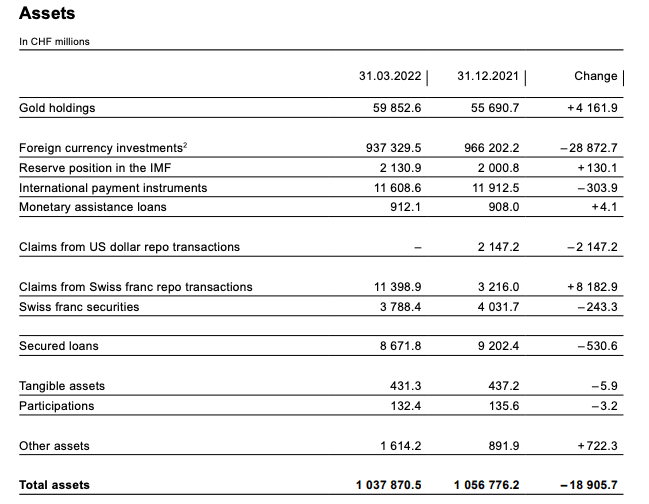Thomas Jordan, the Chairman of the Governing Board of the Swiss National Bank (SNB) talked about Bitcoin in Berne during the central bank’s 114th Ordinary General Meeting of Shareholders on Friday (April 29).
The SNB, which has “two head offices one in Berne and one in Zurich, as well as a branch office in Singapore”, was established in 1907.
According to a report by Reuters (published on Yahoo Finance on April 29), with regard to Bitcoin, Jordan had this to say:
“Buying bitcoin is not a problem for us, we can do that either directly or can buy investment products which are based on bitcoin. We can arrange the technical and operative conditions relatively quickly, when we are convinced we must have bitcoin in our balance sheet.
“But from the current perspective we do not believe bitcoin meets the requirements of currency reserves, that’s why we have until now decided not to have bitcoin on our balance sheet.“
These were the assets on the SNB’s balanace sheet as of 31 March 2022:

Back on 5 September 2019, Jordan talked about cryptoassets in a speech titled “Currencies, money and digital tokens” given at University of Basel:
“The public’s understanding of digital token money has been heavily influenced by cryptocurrencies like Bitcoin. However, cryptocurrencies and cryptocurrency-based tokens are of only limited use as payment instruments, stores of value and units of account because they are subject to major fluctuations. Crypto tokens do not possess the characteristics of ‘good’ money, which is typically stable over time, is broadly accepted, and enables efficient payments. Given these parameters, it seems unlikely that crypto tokens will be widely used as money in Switzerland.
“The picture may be different for stable coins. These are also privately issued digital tokens, however they are pegged to official currencies or backed by stable assets in an effort to minimise fluctuations in value. Thus, in principle, this form of money has the potential to achieve broader acceptance than crypto tokens. For this reason, stable coins will need to be rigorously analysed and classified from a regulatory and monetary policy perspective.
“The benchmark for assessing utility, efficiency, reliability and security is set by the existing systems and the regulations governing comparable activities. Only once there is competition on equal terms will it become clear whether stable coins can be a useful and efficient complement to today’s cash and book money.
“As well as the private sector, public institutions such as central banks could also issue digital token money. Essentially, there are two potential areas of application: One, all households and companies could be given access to tokens. Or, two, tokens could be made available only to commercial banks and other financial market participants, just like sight deposits at the central bank today.
“In Switzerland, granting all households and companies access to digital central bank money, whether in the form of Swiss franc tokens or sight deposits, would involve risks. Furthermore, cashless payments in Switzerland are already reliable, secure and efficient and the system is continuously being updated and refined. The SNB therefore takes a critical view of all households and companies gaining access to digital central bank money.
“The introduction of a state-issued digital token exclusively for financial market participants requires in-depth analysis. If security tokens become established in the financial sector, this will raise the question of whether state-issued digital token money will also be needed as a means of payment for the new financial market infrastructures. The SNB is following developments closely and is actively involved in the debate, not least through its future participation in the BIS Innovation Hub.“
Disclaimer
The views and opinions expressed by the author, or any people mentioned in this article, are for informational purposes only, and they do not constitute financial, investment, or other advice. Investing in or trading cryptoassets comes with a risk of financial loss.
Image Credit
Featured Image by “myshoun” via Pixabay.com









